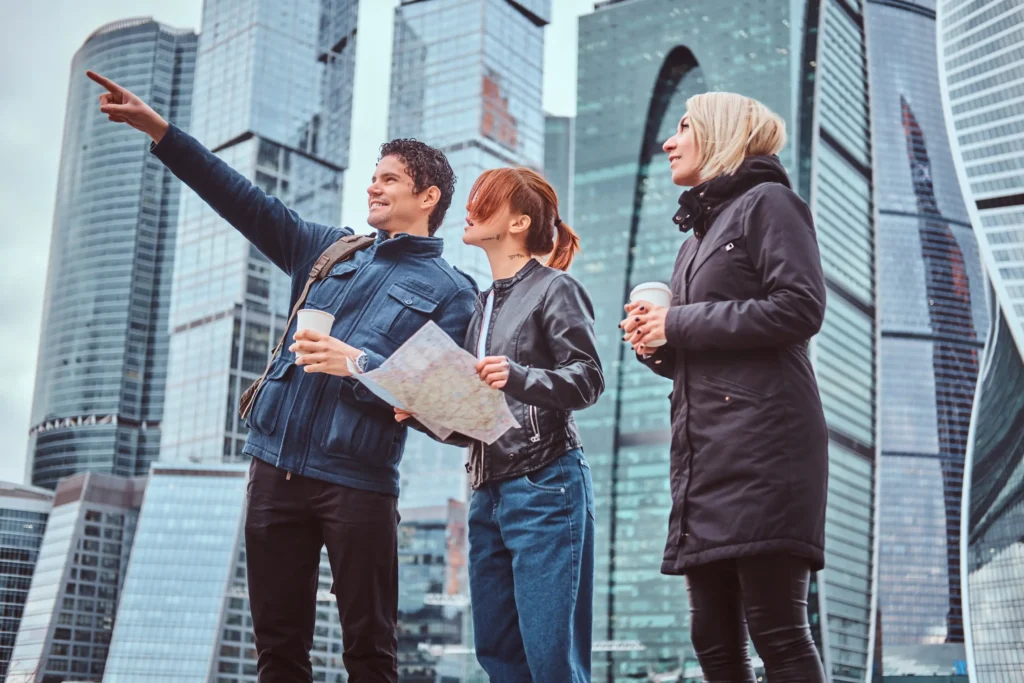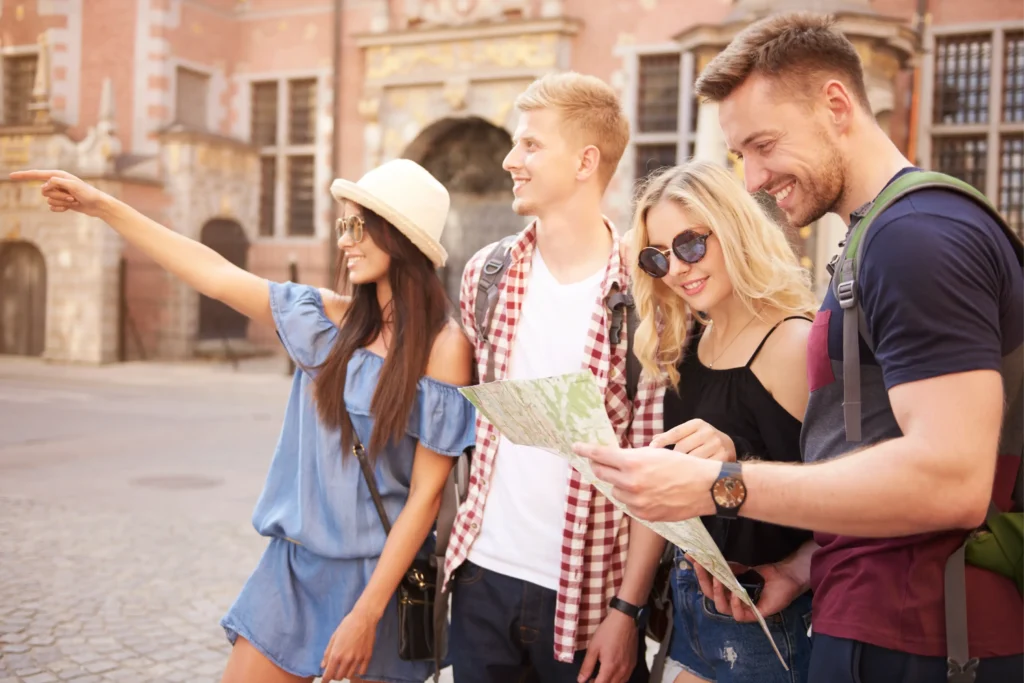Conducting Successful City Tours (2025 Edition)

Urban tourism is booming in 2025, with Eurostat reporting over 3 billion nights spent in EU accommodations in 2024, a record high.
As travel demand surges, city tours face growing competition from both traditional operators and digital-first platforms.
New factors like AI-driven planning, demand for authentic experiences, and sustainability are reshaping what makes tours successful.
This guide outlines how to design and market tours in 2025 with strategies optimized for SEO, AEO, and GEO, supported by data, case studies, and best practices.
Table of Contents
Understanding Your Audience
The key to designing memorable city tours lies in understanding who your travelers are. Different demographics look for different experiences:
- Gen Z and Millennials prefer interactive, visually engaging tours that can be shared on social media. Lisbon’s street art tours, for instance, have gained traction through TikTok and Instagram.
- Digital Nomads seek flexibility and community-focused tours, often combining cultural experiences with modern amenities.
- Older travelers value heritage, comfort, and slower-paced itineraries, making destinations like Rome ideal for cultural and gastronomy-focused tours.
- Eco-conscious tourists prioritize low-carbon tours, such as walking or cycling experiences, to minimize their environmental impact.
The UNWTO reports that 72 percent of urban travelers now prioritize authentic and sustainable activities when choosing tours.
Tip: Use tools like Google Analytics 4, AI-driven sentiment analysis, and social listening to discover what visitors are talking about in your city right now.
Training Tour Guides
Tour guides play a central role in the success of city tours. In 2025, they must serve as storytellers, educators, and cultural ambassadors.
Core skills for guides:
- Mastery of storytelling techniques that connect facts with emotions.
- Integration of technology, such as AR tablets or VR visuals, to enrich experiences.
- Training in inclusivity and empathy to ensure all visitors feel welcome.
- Deep cultural knowledge combined with flexibility to adapt to audience needs.
According to the European Commission, personalization and digital innovation are now core to competitive European tourism.
Case Study: Berlin – Alternative city tours have introduced refugee guides to share personal perspectives, creating unique cultural narratives and raising tour appeal.

Designing the Tour
Successful tours are carefully structured to balance education, entertainment, and flexibility.
Best Practices
- Blend icons and hidden gems: Combine famous landmarks with lesser-known local sites.
- Choose themes: Gastronomy, street art, heritage walks, or innovation-focused itineraries.
- Incorporate interactive elements: Local tastings, workshops, or AR-enhanced visuals.
- Customize options: Seasonal offerings, family packages, and private tours.
- Maintain pacing: Two to three hours is optimal for walking tours.
Example – Copenhagen: The city integrates cycling tours into its tourism strategy, combining environmental responsibility with cultural discovery.
Marketing Your Tours
Marketing determines whether your tours are found and booked. In 2025, optimization must address not only traditional SEO but also AEO (Answer Engine Optimization) and GEO (Generative Engine Optimization).
SEO strategies:
- Use long-tail keywords such as “best walking tour in Paris 2025.”
- Keep your Google Business Profile up to date with reviews, images, and FAQs.
- Build a content hub with blogs, videos, and city guides to attract organic traffic.
AEO strategies:
- Structure content with FAQs to capture voice and AI-driven searches.
- Write in conversational formats that answer specific traveler queries.
GEO strategies:
- Apply structured data markup (FAQ, HowTo, Speakable schema).
- Reference authoritative sources such as UNWTO and Eurostat to increase credibility.
- Create semantically rich content that AI engines can easily interpret.
WeAreTenet notes that businesses implementing AEO and GEO optimization have a higher chance of appearing in AI-generated travel recommendations.
Utilizing Technology

Technology is now inseparable from the visitor experience.
- Mobile Bookings: More than 60 percent of city tours in Europe are booked via mobile.
- AI Chatbots: Provide real-time booking support and personalized recommendations.
- Augmented Reality: Enhance historical tours by overlaying reconstructions of past events.
- AI-Powered Audio Guides: Deliver multilingual, location-aware narratives.
- Social Media Integration: Encourage live sharing with AR filters and interactive content.
Case Study – Tokyo: Many tours now use AI-powered assistants for bookings and integrate AR experiences at key landmarks, providing an interactive layer to traditional sightseeing.
Feedback, Safety and Accessibility
Safety and accessibility are essential for building trust with travelers.
- Safety Protocols: Guides trained in first aid and equipped with emergency response tools.
- Accessibility: Wheelchair-friendly routes, stroller access, and clear communication of physical requirements.
- Feedback Systems: Real-time surveys and ratings via mobile apps.
- Hybrid Models: Virtual and VR-based options for participants with mobility limitations.
Sustainable Tourism
Promoting tourism that is sustainable practices that respect local cultures and minimize ecological impacts, ensuring that tourism benefits communities and preserves destinations for generations to come.
Practices to Adopt
- Promote walking, cycling, or electric vehicle tours.
- Partner with local businesses, artisans, and eco-conscious cafés.
- Replace paper with QR codes and digital tickets.
- Offer discounts for travelers who bring reusable bottles or use public transport.
- Seek certifications such as Travelife and EarthCheck.
The UNWTO Recommendations on Urban Tourism emphasize sustainability as a key principle. A Reuters report shows a surge in alternative accommodations, reflecting tourists’ interest in more sustainable and authentic stays.
Case Study – Ljubljana and Vienna: Both cities have integrated eco-friendly policies into their tourism offerings, making them role models for sustainable urban tourism.

Conclusion
City tours in 2025 are immersive, digital, and sustainable experiences that go beyond sightseeing.
By combining strong storytelling, innovative use of technology, and sustainable practices with SEO, AEO, and GEO optimization, tour operators can remain competitive and relevant.
Tours that embrace these strategies not only attract more visitors but also create deeper cultural connections and lasting memories.
Frequently Asked Questions
What makes a city tour successful in 2025?
A mix of authentic storytelling, innovative technology, sustainable practices, and SEO/AEO/GEO-optimized marketing.
How can I market my city tour online?
Use long-tail keywords, maintain an updated Google Business Profile, create structured FAQs for AEO, and cite authoritative sources for GEO optimization.
Which technologies improve city tours today?
Mobile-first booking systems, AI chatbots, augmented reality, and AI-powered audio guides.
How do city tours support sustainable tourism?
By reducing carbon emissions, supporting local economies, and educating travelers about cultural and environmental respect.
Which cities are leading in innovative city tours?
Lisbon, Berlin, Rome, Copenhagen, and Tokyo each demonstrate unique approaches to combining culture, technology, and sustainability.
How long should a city tour last?
The ideal length is 2–3 hours for walking tours. Shorter tours (60–90 minutes) work well for specific themes, while half-day tours are suitable for in-depth cultural or gastronomic experiences.
What role does social media play in promoting tours?
Social media is crucial in 2025, especially TikTok, Instagram Reels, and YouTube Shorts. Short-form videos showcasing highlights can drive significant bookings, particularly among Gen Z and Millennials.
Why is accessibility important for city tours?
Accessible tours expand your audience and improve customer satisfaction. Since Google’s accessibility update in 2024, tours that highlight accessibility features rank higher in search results.
How can tour operators collect useful feedback?
Use digital surveys, real-time rating apps, and follow-up emails. Encourage reviews on Google, TripAdvisor, and social platforms to build social proof and improve local SEO.
What are common mistakes city tour operators should avoid?
Overloading itineraries, ignoring customer pacing, neglecting accessibility, failing to optimize online presence, and not updating tours regularly to reflect local events and trends.
What trends are shaping city tours in 2025?
Growth of AI-powered planning, demand for sustainable experiences, mobile-first bookings, AR-enhanced tours, and stronger regulation around short-term rentals and urban crowd management.
How can city tours compete with self-guided travel apps?
By offering personalized storytelling, cultural interactions, and immersive experiences that technology alone cannot replace. Hybrid models that combine human guides with AR/VR can also add value.
What certifications help tour operators build trust?
Sustainability-focused certifications such as Travelife and EarthCheck, as well as local tourism board accreditations, demonstrate professionalism and responsible practices.


